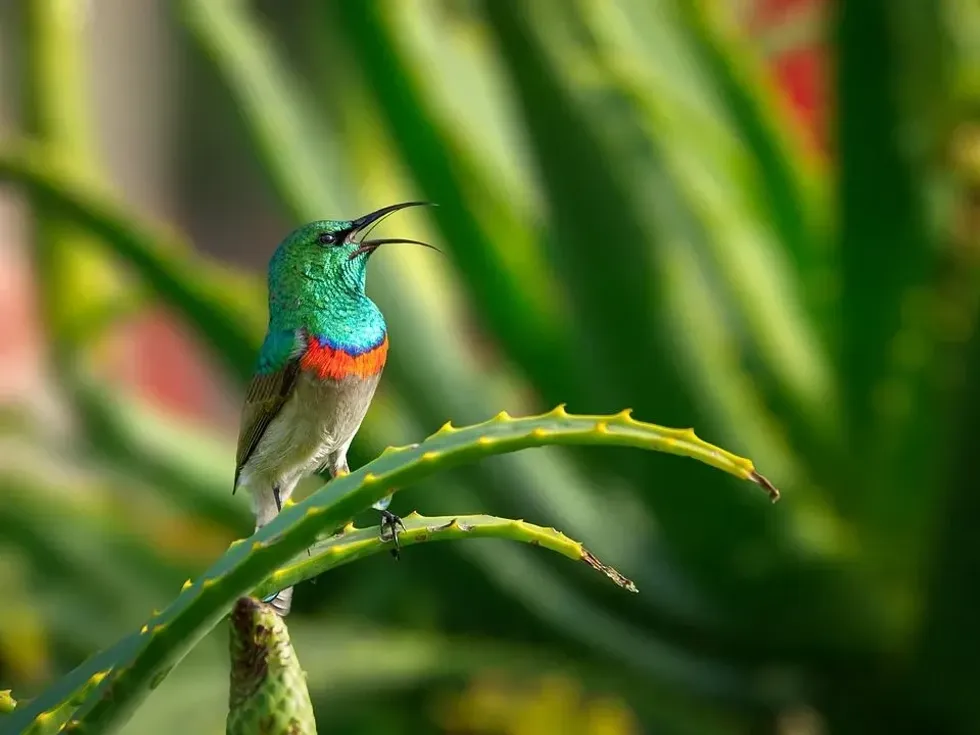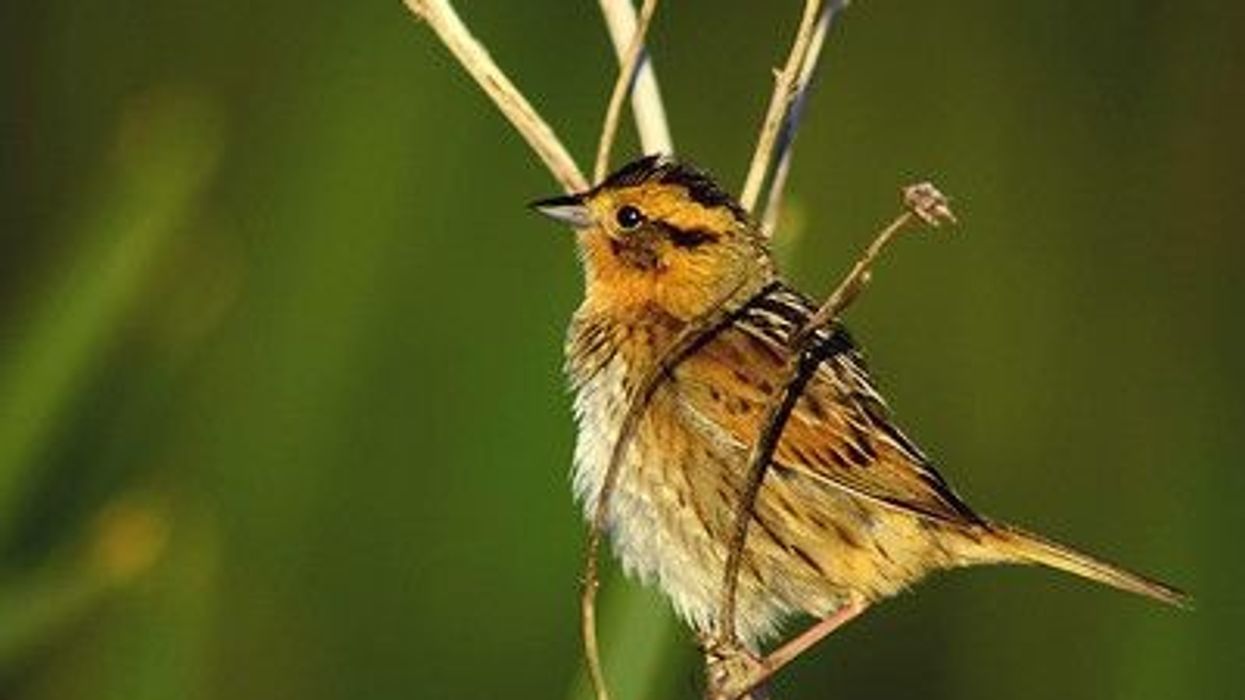Sunbirds are small and slender passerines that have about 145 species in 16 different genera. They are usually found in rainforests or savannahs in Africa, Asia, and Australia.
A sunbird's diet includes nectar from flowers, small plants, and fruits. Some species are insectivores that hunt spiders or other small insects too.
Males are known to perform a courtship sequence where they spread their wings and flick their tails to attract a mate. Their nest construction is done a few days before mating, after which sunbirds lay between one and four eggs.
A female sunbird builds purse-shaped shelters out of twigs, spiderwebs, paper, and leaves while the male defends its nest or territory. This nest is usually built on a plant or tree branch.
The colors of sunbirds are mainly bright for males whilst females have a dull plumage. They are short, slender, and have long downward tilted bills. If you want to find out more about sunbirds, keep reading these interesting sunbird facts! You can also read about other species of birds like Pesquet's parrot and the bowerbird.
Sunbird Interesting Facts
What type of animal is a sunbird?
Sunbirds are a type of bird from the Old World bird family that is found in Africa, Southeast Asia, and Australia. They are known to build purse-shaped shelters and this nest is usually suspended in the air with the help of spider webs.
What class of animal does a sunbird belong to?
The sunbird belongs to the Aves class and the family Nectariniidae. Their scientific name depends on the species, with two examples being Cinnyris asiaticus and Cinnyris jugularis.
They are often confused with New World hummingbirds because of their feeding style, but these two types of birds are not the same. Hummingbirds are only found in America and hover to feed on nectar from plants, but, whilst some sunbirds do suck nectar while hovering, they mostly perch on tree branches.
How many sunbirds are there in the world?
There are about 145 species of sunbirds in 16 genera. There are no specific studies estimating the population of these birds but their numbers are relatively stable.
Where does a sunbird live?
Different sunbird species are found all around the world. Some of the habitats they live in include tropical rainforests, open woodlands, and savannahs. They are mainly found in the scrublands of Africa, South Asia, parts of the Middle East, and Australia. Species diversity is at its highest in equatorial areas.
What is a sunbird's habitat?
The sunbird is a very adaptable species and can be found in the wild, as well as in urban areas. They can be spotted in tropical rainforests, woodlands, savannahs, alpine forests, and coastal forests. Sunbirds also inhabit man-made settings like agricultural areas, plantations, and gardens.
Who do sunbirds live with?
Sunbirds mostly live in pairs or very small groups. They can sometimes be seen alone as well. During the breeding season, they can be quite territorial and they protect their nests with their partners.
How long does a sunbird live?
The lifespan of sunbirds is as variable as their species. The average lifespan of sunbirds falls under the range of seven to 22 years.
How do they reproduce?
Equatorial sunbirds breed throughout the year and those outside the equatorial belt only breed seasonally. Sunbirds are monogamous birds and males aggressively defend their breeding territory and their nest against other birds.
Before mating, females build purse-shaped suspended nests with the help of spider webs, leaves, feathers, twigs, or human litter such as paper. Males perform a courtship dance by spreading their wings to attract potential females.
The females will lay between one and four eggs and the hatching time can vary according to the species.
For example, for the purple sunbird, it can take about 12-15 days for the eggs to hatch. While only females incubate the eggs in most sunbird species, in spiderhunters both sexes aid in incubation.
What is their conservation status?
The conservation status of most sunbirds is Least Concern and they are welcomed in many gardens and plantations. About seven sunbird species are classified as Threatened and the elegant sunbird is officially Endangered. Overall, the bird's population trend is either stable or declining, and this varies according to different species.
Sunbird Fun Facts
What do sunbirds look like?
Sunbirds are small, slender birds with long and slightly crooked bills. Their wings are short and their tongues are tube-shaped to access nectar conveniently. Some family groups also have long tail feathers as well. Males have bright plumage, while females have dull feathers.
The main colors of sunbirds include yellow, green, orange, blue, and red. Spiderhunters are the most distinct sunbirds in appearance and are larger than many other sunbirds. Both males and females of this sunbird species have brown plumage.
How cute are they?
Sunbirds are colorful and very pleasant to look at. They are usually small in size and can be seen bathing in water sources like a birdbath or ponds. They are also very hardworking, making them a cute bird species!
How do they communicate?
They usually communicate using high-pitched calls and songs. They also communicate via behavioral changes and body language, for example, the courtship dance that the male sunbird does for the female is evidence of using body language to communicate.
How big is a sunbird?
Males are generally larger than females. The average size of a sunbird ranges from 4-10 in (10-25 cm). A large sunbird can be double the size of a hummingbird.
How fast can a sunbird fly?
The exact speed of the sunbird is not known.
How much does a sunbird weigh?
The average weight of sunbirds falls in the range of 0.1-1.5 oz (5-45 g). The spectacled spiderhunter is the largest sunbird and weighs 1.6 oz (45 g).
What are the male and female names of the species?
There are no specific names for male and female sunbirds.
What would you call a baby sunbird?
Baby sunbirds can be called chicks, like many other baby birds.
What do they eat?
Sunbirds feed on nectar from flowering plants. They can visit flowers belonging to more than 20 different plant genera including, aloe, acacia, and jacaranda.
Some species are insectivores and feed on small insects or spiders. Males are known to chase away any other birds that are feeding on the nectar sources in their territories. The main predators of sunbirds are white-lipped pit vipers, bronze tree snakes, Asian koels, and parasitic cuckoo birds.
Are they dangerous?
Sunbirds are harmless to human beings and are very good pollinators. They are considered pests in cocoa plantations though because they can unintentionally spread parasites that stick to their plumage.
Would they make a good pet?
Sunbirds have a high metabolism and need a constant stream of energy from their food intake. Because of this, they do not make good pets. In some areas where these birds are endangered, it is illegal to own one.
Did you know...
Sunbirds can be found from sea level to an elevation of about 14,700 ft (4,500 m).
Types of sunbird
There are about 145 species and 16 different sunbird genera. Some of the species' names include the splendid sunbird, spiderhunters, the Palestine sunbird, the olive-backed sunbird, the orange-breasted sunbird, the regal sunbird, the African sunbird, and the elegant sunbird.
Do sunbirds migrate?
Only some species of sunbirds migrate, and they only travel short distances. This is because most species can find flowers or a food source in their natural habitats. They will only migrate if heavy rains make it difficult to find a stable food supply.
How do you attract sunbirds?
The more feeding opportunities a place has, the more chance there is of attracting sunbirds. Hamelia patens (scarlet bush plants), red-hot pokers, aloes, and wild daggas are the best plants to lure a sunbird into your garden.
You can also use a nectar feeder with sugary solutions or birdbaths as an easy option to try and attract these beautiful birds!
Here at Kidadl, we have carefully created lots of interesting family-friendly animal facts for everyone to discover! Learn more about some other birds including the European starling or the common raven.
You can even occupy yourself at home by drawing one on our Sunbird coloring pages.









